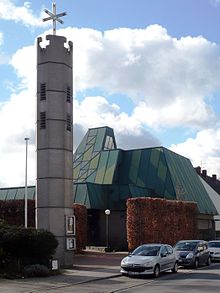Christ the King Church (Essen)
The Christ the King Church is a Catholic church building in the Haarzopf district of Essen .
It was built in 1976/77 on the site of the first church in the parish from 1929 and is shaped by the renovations carried out by the Second Vatican Council (1962–1965). The church was consecrated on August 21, 1977 by the Bishop of Essen, Franz Hengsbach . The architect was Ernst A. Burgharts.
The church building
The foundation stone of the previous building of today's Christ the King Church, whose architect was Emil Jung, was laid on May 5, 1929 and the inauguration on October 27, 1929.
Today's church is reminiscent of a tent and symbolically indicates that people are on the move as God's people. The ceiling beams are arranged like the struts of a tent. The center of the church is the altar. The signs for the risen One who is enthroned on the right hand of the Father are somewhat hidden in the light tower above the altar.
The altar made of Hungarian marble is carved out of a block according to the architect's design in the shape of a blossoming blossom. The figure of the crucified hangs on a concrete pillar. The figure of Christ was designed by Gottfried Kappen († 1981) from Kirchhellen.
The symbols in the light tower
Christ is indicated in signs as Pantocrator . In the light tower above the altar an eye is shown above, below a speaking mouth, then a blessing and a teaching hand. In the middle is a book with the alpha and omega, including Werner Heisenberg's world formula as a modern symbol for world events. At the very bottom the left foot is stretched out, an indication of Christ's coming in glory.
Tongues of fire descend from the light tower, signs for the Holy Spirit. These tongues of fire are directed towards the altar on which Christ is present in the sacrament.
Tongues of fire over the church
Flames descend from the small light tower above the altar of the church. They are aligned with the altar; but they are also distributed under the roof on all sides, so that tongues of fire stand all around the church over the congregation. In this way the Pentecost event is represented and related to the church.
The ambo
The ambo is shaped like an eagle with outstretched wings that carry the book with the word of God. The ambo is also a work by G. Kappen.
Mary - the mother of Christ
The figure of Mary is a replica from the Premonstratensian monastery in Steingaden , a typical baroque figure. The playful, splendid garment interwoven with gold takes the simplicity of the simple woman from her. The gesture of her hand is stylized, not natural. She presents her son rather than holding him. He's playing with his mother's fingers. The piety of this time no longer expresses the longing for heaven, heaven itself is represented.
The design of the Marienwand takes a back seat, Mary is the focus, appears lively and powerful. A large steel plate delimiting the room calms the background.
The Way of the Cross
With this first station “Jesus is condemned to death by Pilate” the way of the cross begins . The fifteen Stations of the Cross - 30 to 40 cm large clay sculptures - were created by Ute Hampel from the community. The Way of the Cross was inaugurated in 1985 by Bishop Franz Hengsbach.
The organ
The organ was built by the Stockmann brothers' organ building company in Werl-Westphalia. The design was carried out in collaboration with the diocese of Essen, Cantor M. Elbers and master builder Dr. Heinz Dohmen . The organ was inaugurated on Easter Monday, April 4th, 1988.
Saints of all peoples and times
The Cologne artist Professor Hubert Berke has created a glass wall with 32 life-size saints facing the viewer: Moses and Isaiah , John the Baptist , Augustine , Martin von Tours , Franz von Assisi , Suitbert , Liudger and Altfrid , Franz von Xaver , Rosa von Lima , African martyrs from Uganda, martyrs in Japan, Elisabeth Ann Seton and Maximilian Kolbe .
Bells
Three small bells hang in the bell tower made of precast concrete parts. They are tuned to: c sharp ′ ′ - e ′ ′ - f sharp ′ ′. The two larger bells were cast in 1979 by the bell foundry Petit & Gebr. Edelbrock from Gescher. The small fis bell was originally cast by the Otto bell foundry from Hemelingen / Bremen in 1883 for the parish of St. Markus in Essen-Bredeney, but left it to the Christ the King Church.
See also
Web links
Individual evidence
- ↑ District page of Haarzopf: History of the Catholic Church Congregation ( Memento of the original from April 13, 2015 in the Internet Archive ) Info: The archive link was inserted automatically and has not yet been checked. Please check the original and archive link according to the instructions and then remove this notice. ; accessed on October 12, 2018
- ^ Gerhard Reinhold: Otto bells. Family and company history of the Otto bell foundry dynasty . Self-published, Essen 2019, ISBN 978-3-00-063109-2 , p. 588, especially page 503 .
- ↑ Gerhard Reinhold: Church bells - Christian world cultural heritage, illustrated using the example of the bell founder Otto, Hemelingen / Bremen . Nijmegen / NL 2019, p. 556, especially p. 470 , urn : nbn: nl: ui: 22-2066 / 204770 (dissertation at Radboud Universiteit Nijmegen).
Coordinates: 51 ° 25 ′ 13.9 ″ N , 6 ° 58 ′ 8.9 ″ E
